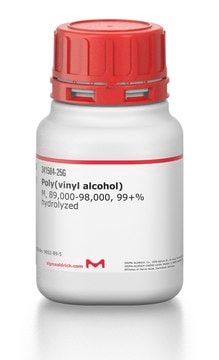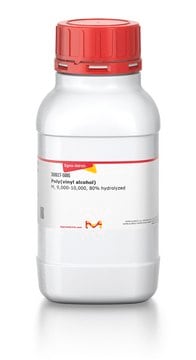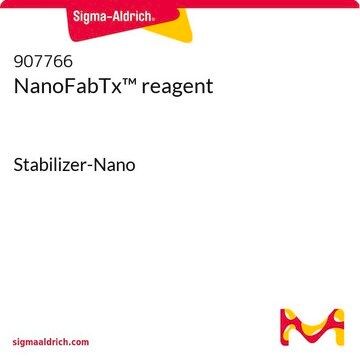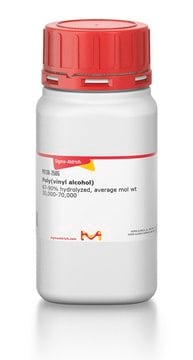81383
Mowiol® 8-88
Mw ~67,000
Synonym(s):
Poly(vinyl alcohol)
Sign Into View Organizational & Contract Pricing
All Photos(1)
About This Item
Linear Formula:
[-CH2CHOH-]n
CAS Number:
MDL number:
UNSPSC Code:
12352104
NACRES:
NA.23
Recommended Products
form
crystals
Quality Level
mol wt
Mw ~67,000
extent of labeling
86.7-88.7 mol% hydrolysis
~1,400 polymerization
impurities
10.0-11.6% residual content of acetyl
ign. residue
≤0.5%
viscosity
7-9 mPa.s, 4 % in H2O(20 °C)
ester number
130‑150
InChI
1S/C2H4O/c1-2-3/h2-3H,1H2
InChI key
IMROMDMJAWUWLK-UHFFFAOYSA-N
Looking for similar products? Visit Product Comparison Guide
Application
- Polyvinyl alcohol coating releasing fungal blastospores improves kill effect of attract-and-kill beads: This study evaluates the use of different types of polyvinyl alcohol (PVA), including Mowiol® 8-88, for developing fungal blastospore coatings that enhance pest control efficacy (KM Hermann et al., 2023, Springer).
- Biodegradable nanoparticles made of amino-acid-based ester polymers: Discusses the use of Mowiol 8-88 in the preparation of biodegradable nanoparticles, analyzing their stability and aggregation properties (T Kantaria et al., 2016, MDPI).
Legal Information
Mowiol is a registered trademark of Kuraray Europe GmbH
Storage Class
11 - Combustible Solids
wgk_germany
WGK 1
flash_point_f
No data available
flash_point_c
No data available
ppe
Eyeshields, Gloves, type N95 (US)
Choose from one of the most recent versions:
Already Own This Product?
Find documentation for the products that you have recently purchased in the Document Library.
Customers Also Viewed
Kelly E Coller et al.
PLoS pathogens, 5(12), e1000702-e1000702 (2009-12-31)
Hepatitis C virus (HCV) enters hepatocytes following a complex set of receptor interactions, culminating in internalization via clathrin-mediated endocytosis. However, aside from receptors, little is known about the cellular molecular requirements for infectious HCV entry. Therefore, we analyzed a siRNA
Cijun Shuai et al.
Biofabrication, 5(1), 015014-015014 (2013-02-07)
A tetragonal polyvinyl alcohol (PVA) scaffold with 3D orthogonal periodic porous architecture was fabricated via selective laser sintering (SLS) technology. The scaffold was fabricated under the laser power of 8 W, scan speed of 600 mm min(-1), laser spot diameter of 0.8 mm
Sreejith Raveendran et al.
Carbohydrate polymers, 92(2), 1225-1233 (2013-02-13)
Extremophilic bacterial polysaccharide based biocompatible nanofibers were produced for the first time via electrospinning technique. Mauran (MR), an extremophilic sulfated exopolysaccharide was extracted from moderately halophilic bacterium, Halomonas maura and characterized for the application of nanofiber synthesis. Thin-uniform MR nanofibers
Roger F Falkenstern-Ge et al.
Journal of bronchology & interventional pulmonology, 20(1), 58-62 (2013-01-19)
Emphysema is a progressive and irreversible disease for which there is no cure to date. The patients experience debilitating shortness of breath with repetitive exacerbations and poor quality of daily life. At present, patients with severe emphysema have limited treatment
Miao Zhang et al.
Journal of visualized experiments : JoVE, (73)(73), e4335-e4335 (2013-03-15)
Existing protocols for the generation of neurons from human pluripotent stem cells (hPSCs) are often tedious in that they are multistep procedures involving the isolation and expansion of neural precursor cells, prior to terminal differentiation. In comparison to these time-consuming
Our team of scientists has experience in all areas of research including Life Science, Material Science, Chemical Synthesis, Chromatography, Analytical and many others.
Contact Technical Service



![1,4-Diazabicyclo[2.2.2]octane ReagentPlus®, ≥99%](/deepweb/assets/sigmaaldrich/product/structures/366/129/a6ff4175-974d-4fac-9038-b35e508ef252/640/a6ff4175-974d-4fac-9038-b35e508ef252.png)



